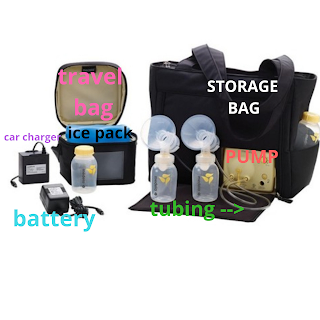The breast pump
When you plan on nursing whether its from baby to breast, baby to breast and bottle, or just using bottles, its great to know how to use a breast pump correctly and most woman at some point will use a breast pump.
A breast pump expresses milk using a similar rhythm of suction a baby would use to expel the milk.
Why use a breast pump?
Women use them for all types of reasons like if baby isnt emptying your breasts after a feed and you still feel full, you have a clogged duct and want to express as much milk as you can, to increase your milk supply by pumping before or after each baby to breast feed, having a over supply of milk so pumping between each feeding, moms who work away from baby and need relief at work while also having to have milk stored for the person with her baby, to build a supply of milk in your freezer if its for your baby or to donate, whenever youre separated from baby for a few hours but still need to empty your breasts, and for woman who want to give their baby breastmilk but baby was premature or didnt catch on to latching correctly and any other difficulties that cause baby to not take to the breast.
Types and price of breast pumps?
Theres electric pumps, hand free pumps, hand pumps, and even pumps you can place inside your bra. Electric pumps are normally going to be the more expensive ones ranging from 100 - 300 dollars and sometimes that doesnt include all the extra parts you need with it. Most insurances will cover the cost of a breast pump, you just go to your obgyn and they will write you a script for a new breast pump, your insurance will take care of the rest. With having your insurance cover the breast pump that could mean you dont get to pick the pump you want. Sometimes the insurance company will give you a check of a certain amount and you go and get a pump with the amount they will cover, other times they will have you pick up a certain pump at your pharmacy.
A hand pump is a great cheaper option, they normally range from 20-60 dollars and you can get them at most stores like walmart, target, cvs, or any other stores like those. Hand pumps are great to keep in the house as a back up incase your electric pump crashes or even to keep in car.
How long is my pump good for?
Most pumps have a warranty up to 1 year. But pumps tend to last longer than that. Depending on how much you use your pump it can last several months to several years.
Parts of a breast pump?
Almost all breast pumps of different brands have the same parts, just some parts may be slighty different in size or shape or 1 part more or 1 part less compared to others. For this post i am using the medela as an example.
PUMP
The pump itself is yellow and square and is surrounded by a black soft cover that will fold in the front with velcro to cover the pump when not in use. There is a knob on the pump that you use to set the rhythm and suction speed from slow to very fast. This suction mimics a nursing baby. There is a small black hole on the pump under the knob used for speed, this hole is where you plug the battery into that connects to a outlet. Finally on the pump there are 2 small holes divided by a yellow plug. These holes are what you connect the tubing to and the yellow divider is used to plug one of those holes at a time. (Ex. If you only need to pump one breast you use the divider plug to plug the hole youre not using, this way you're blocking any air coming out and get your max pump, using tubing to plug the hole will not work)
TUBING
The tubing is clear and normally 42 inches in length. You will need two tubes to pump both breasts at once. The clear end of the tubes will connect to the holes on the pump that are divided by the divider plug. The end of the tubing with the yellow tip will connect to the connector.
BATTERY
The battery is black and connected to a cord that you plug in an outlet on one end and the other end is a small tip that you plug into the black hole on the front of the pump under the speed knob.
CONNECTOR
The connector is clear and has 3 separate holes on it. The hole on the top (sticks out at an angle) is where you put the nipple shield. The hole directly diagonal from the top hole is where you plug your tubing into (smallest hole), the last hole at the bottom of the connector (largest hole) connects the valve.
VALVE
The valve will sometimes come already connected to the connector but it is a separate part and needs to be cleaned unconnected. The valve is yellow and small it also has 4 small holes on the flat part of the valve. (Rounded on top to connect to the connector)
MEMBRANE
The membrane is a small white thin pad. The membrane goes onto the valve where the 4 holes are. Its a good idea to have extra membranes as they need changed regularly.
NIPPLE SHIELDS
This is the part that makes contact with your nipples. The sheilds are clear with a tunnel at one end which connects to the top of the connector and a rounded top that will be placed on the nipple. You want to make sure you have the right fit. The standard size that comes with most pumps is 24mm, but there are other sizes available. To make sure you have the right size ask yourself these:
Any pain or discomfort while pumping?
Does your nipple rub the sides of the shield?
Is there an excessive amount of unfilled area in the tunnel of the sheild while pumping?
Is an excessive amount of the areola being pulled into the tunnel while pumping?
Redness?
Nipple or areola turning white?
Still feeling full after pumping?
If you say yes to any of those it may be a good idea to look into a different size sheild.
*note* sometimes you may need different size sheilds for each nipple
BOTTLES
Normally you will have to use bottles that go with the brand of the pump you are using. The bottles are connected to the part of the connector that has the valve, these collect the pumped milk. Bottles will come in 5ml to 8ml. Lids for the bottles will come with them mostly, the lids are normally yellow. You must use the lids while storing your milk in the bottles, the connectors do not protect the milk from being exposed to germs or spilling.
ACCESSORIES
These are things that are great to have but arent necessary,
1. Storage bag - these hide the pump and has a large compartment to carry all the pump parts and looks like a bag so you can carry it. Great for a working mom.
2. Travel bag- these are smaller and meant to transport pumped milk
3. Ice pack - these go into the travel bag and are grooved to fit the bottles of milk perfectly. This will keep milk fresh for up to 6 hours.
CLEANING YOUR PUMP
Never put the pump itself in contact with water. Do however remove the pump out of the black cover and wipe it off along with wiping the inside of the cover out. Moisture can get trapped and cause mold to grow. Do this at leasr once a month.
Bottles,lids,valve, connector, and shields can be hand washed in warm soapy water then rinsed with clean water and set to air dry. Dont store wet or damp parts this will cause mold. These parts are also dishwasher safe. It is also a idea to rinse all those parts with clean water after each pumping session. Clean these parts regularly.
For the membrane you can unconnect it and clean it with soapy water and reuse it but be sure to change with a new one every once in awhile.
While cleaning the tubing first you must remove it from the pump then you can use soapy warm water, rinse with clean, and hang to air dry. While cleaning is good, you should change the tubing to new tubing evey once in awhile.
Every once in awhile you should put all parts in boiling water for about 10 minutes to sterilize them.
*Note* be sure to have extra pump parts, you never know when one will go bad. Also, make sure you buy pump parts for the brand pump you have.
*note* for a hand pump the connector will still connect to the nipple shield, valve, and bottle. Instead of connecting to tubing inplace will be a handle, sometimes the handle is already part of it and sometimes you connect it, the handle will go where the tubing would go. You just press down on the handle up and down and milk will be expressed into the bottle.
*note* for a hand pump the connector will still connect to the nipple shield, valve, and bottle. Instead of connecting to tubing inplace will be a handle, sometimes the handle is already part of it and sometimes you connect it, the handle will go where the tubing would go. You just press down on the handle up and down and milk will be expressed into the bottle.



Comments
Post a Comment